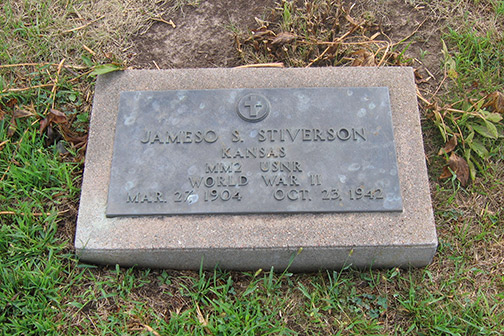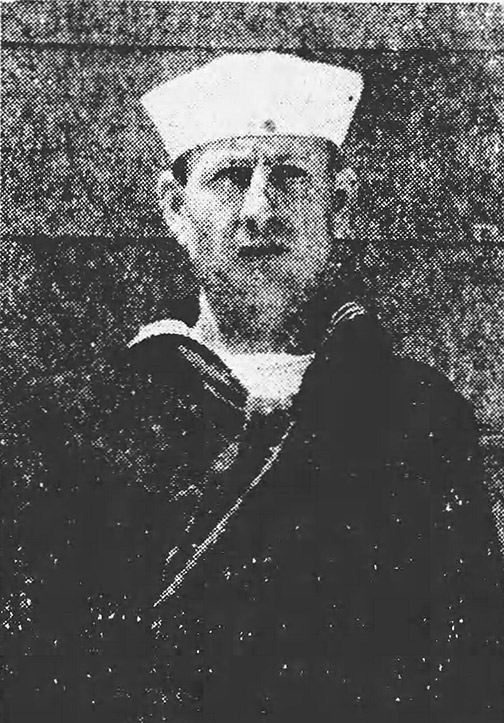James S. Stiverson
Full Name: Jameso Samuel Stiverson
Date of Birth: March 27, 1904
Place of Birth: Irving, Marshall Co., Kansas
Father and Mother’s Names: Frank J. Stiverson and Eddie Elizabeth (Lane) Stiverson
Spouse's Name: Flossie Ruth (Zentz) Stiverson
Date Entered Service: Enlisted January 1942, Activated April 1942 in Topeka, Kansas.
Service Branch: Navy Reserves
Rank/Specialty: Machinist Mate Second Class
Service ID: 6283020
Division/Company/Unit info: Company A, 6th NCB (Naval Construction Battalion)
Riley Connection: NARA (National Archives) list Jameso's next of kin home of record as Riley Co., KS. Jameso lived in Riley, Ks from 1935-1940.
Date of Death (and Age): October 23, 1942 (age 38)
Place of Death: Killed in Action - Henderson Field, Guadalcanal, Solomon Islands.
Grave Location: Greenwood Cemetery, Blue Rapids, Kansas (cemetery was originally Irving, Kansas, and the graves were relocated to accommodate the construction of the Tuttle Creek Reservoir).
Bio: Jameso Samuel Stiverson was born on March 27, 1904 in Irving, Marshall Co., Kansas to Frank J. Stiverson and Eddie Elizabeth (Lane) Stiverson. Jameso worked for the Union Pacific Railroad for a period of time and was a skilled mechanic. Jameso was 38 years old and probably would not have been called to service in WWII, but he decided to enter and help the war effort with his skills. Jameso joined the Naval Reserve and was attached to the 6th Naval Construction Battalion (SeaBees), Company A. It was just a few months later that his unit was sent to Guadalcanal. His Construction Battalion was the first of their kind to be sent into combat. The Japanese had constructed an airfield in Guadalcanal and the Allied forces had taken it over. Jameso and his unit were given the job to improve the airfield and repair it from daily bombings by the enemy. During these bombings and sniper fire, MM2 Jameso Samuel Stiverson was Killed in Action. He had sent his last letter home dated 10/4/1942 where he told his family that the "Japanese were bombing the Hell out of us" and he looked forward to a furlough that would bring him home for Christmas. He was killed 19 days later.
History of the 6th Naval Construction Battalion: The 6th NCB, which was destined to be the first naval construction battalion to come under enemy fire, was activated at Camp Allen, Virginia, on 24 June 1942, and went from Gulfport, Mississippi, to Moffett Field, California, and on to San Francisco. It left for the south Pacific on 21 July on the USS President Polk and the USS Wharton with five other ships escorted by the light cruiser USS Helena (CL-50). The 6th NCB reached Esprito Santo on 11 August via Pago Pago, Samoa. On 20 August Lieutenant Commander Joseph P. Blundon, CEC, USNR, who was Officer-in-Charge of the 6th NCB, arrived in a PBY which landed off Lunga Point. He immediately called on General Vandegrift and his planning was directed at work on Henderson Field. Lieutenant Commander Blundon requested two companies from his NCB at Esprito Santo be sent forward with a few extra men trained for special details such as water purification and machinery repair. Early in the week of August 24th, directions were received from Commander, South Pacific Amphibious Force (Task Force 62, Rear Admiral R. K. Turner, USN) to transfer four hundred personnel to Cactus, two hundred each on the transport USS Fuller (AP-14) and the cargo ship USS Betelgeuse (AK-28). Companies A and D were designated and boarded the USS Betelgeuse on Saturday. This first contingent landed on 1 September 1942 and consisted of 357 men and five officers under Lieutenant (Junior Grade) Thomas L. Stamp, CEC, USNR. When the Marines finally invaded nearby Guadalcanal, the men of the 6th Naval Construction Battalion followed them ashore and thus became the first Seabees to build under combat conditions. They immediately began the arduous task of repairing the airfield, now named Henderson Field that they had earlier helped to destroy. This became a never-ending job, because as fast as the builders leveled the strip and put down Marston matting, the Japanese would send bombers overhead to drop high explosives on their work. Nevertheless, in the midst of battle, the Seabees were able to repair shell and bomb holes faster than the Japanese could make them. The Allied pilots desperately needed the use of Henderson Field, so the Seabees kept this precious airstrip in almost continuous operation.



